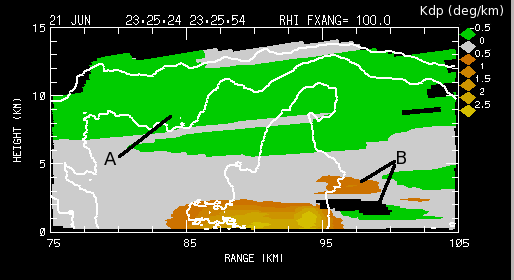An RHI scan through a severe thunderstorm: 21 June 2010
Overview
RHI scan through the outflow / inflow interface of a severe thunderstorm on 21 June 2010. In addition to the Kelvin-Helmholtz circulations on this interface, dual-polarization indications of heavy rain, hail, etc. were also observed.
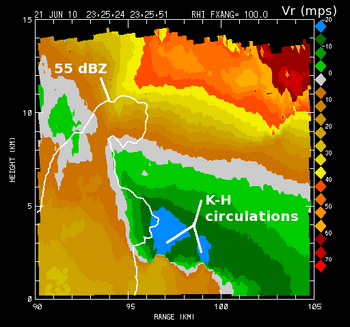
Introduction
The CSU-CHILL radar observed several severe thunderstorms during the afternoon hours of 21 June 2010. At ~2330 UTC Morgan County Colorado was being affected by this activity. The severe weather reports compiled by the Storm Prediction Center include 1.5 inch diameter hail 1 mile south of Brush at 2316 UTC and 1.0 inch diameter hail and 60 mph wind gusts 5 miles northeast of Brush at 2333 UTC. An RHI volume scan in the vicinity of these severe weather reports was made at 2325 UTC. The sweep done on the 100 degree azimuth captured some notable features.
Reflectivity and radial velocity
In all of the following plots, the basic reflectivity structure is indicated by three reflectivity values (15, 35, and 55 dBZ) plotted with solid white contour lines. The unfolded radial velocities exceed 60 mps in the anvil-level outflow region (point A). At low levels, a sharp interface is present between the surface-based outflow and the elevated strong inflow layer. Local velocity couplets along this interface are indicated by point B. Wakimoto et. al. (BAMS, July 1996; Fig. 7) have related similar couplets to Kelvin-Helmholtz instabilities.
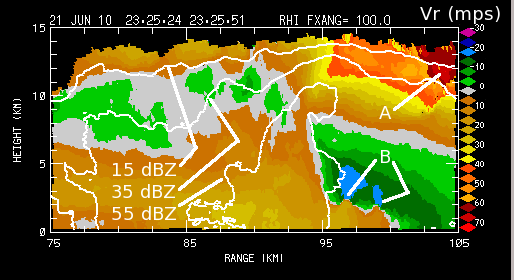
Differential reflectivity
Positive Zdr values reach their greatest heights where oblate raindrops are being carried aloft by the updraft (point A). At low heights within the 55 dBZ echo core (point B), the presence of quasi-spherical / tumbling hailstones reduces the Zdr from the positive values present in the neighboring rain areas.
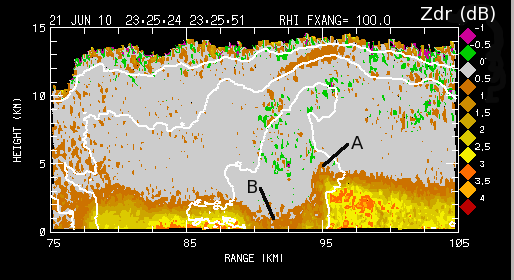
Linear depolarization ratio
The least negative Ldr values overlap and extend above the positive Zdr column in the updraft region (point A). This enhanced cross-polar returned power component is probably due fairly high density and/or wet ice particles growing in the updraft. Some distance to the rear of the strong convective region, there is a suggestion of enhanced Ldr near the melting level (point B).
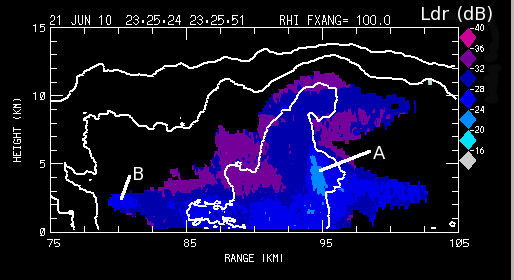
Propagation differential phase
In the upper levels of the echo system, the propagation differential phase color change sequence with increasing range corresponds to the upward direction on the color scale. (i.e. purple at closer ranges changing to pink with increasing range at point A). This phase profile indicates that a significant concentration of ice crystals have had their major axes rotated into the vertical direction due to the strength of the local electric field. This preferential orientation acts to retard the propagation of the V-polarized pulse relative to H-polarized pulse. In contrast, when the radar pulses travel through the many oblate raindrops near the surface in the echo core, the H pulse phase increasingly lags that of the V pulse and the color change sequence follows a downward movement along the color scale (purple, green, orange, etc.) In the inflow region of the storm, this steady color progression is disrupted by the local fluctuations marked at point B.
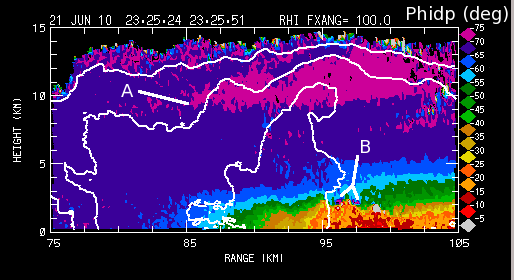
Specific propagation differential phase
The range derivative of phidp (Kdp) is slightly negative in the general area where vertically-oriented ice crystals are expected (point A). Positive Kdp values of several degrees per km occur in the heaviest rain areas. A small additional area of positive Kdp values were detected in an elevated portion of the storm inflow (point B upper branch). This may be caused by raindrops that are being recirculated into the inflow. Due to the noisy phidp profile noted above, no Kdp values could be calculated in some portions of the inflow region (point B lower branch).
